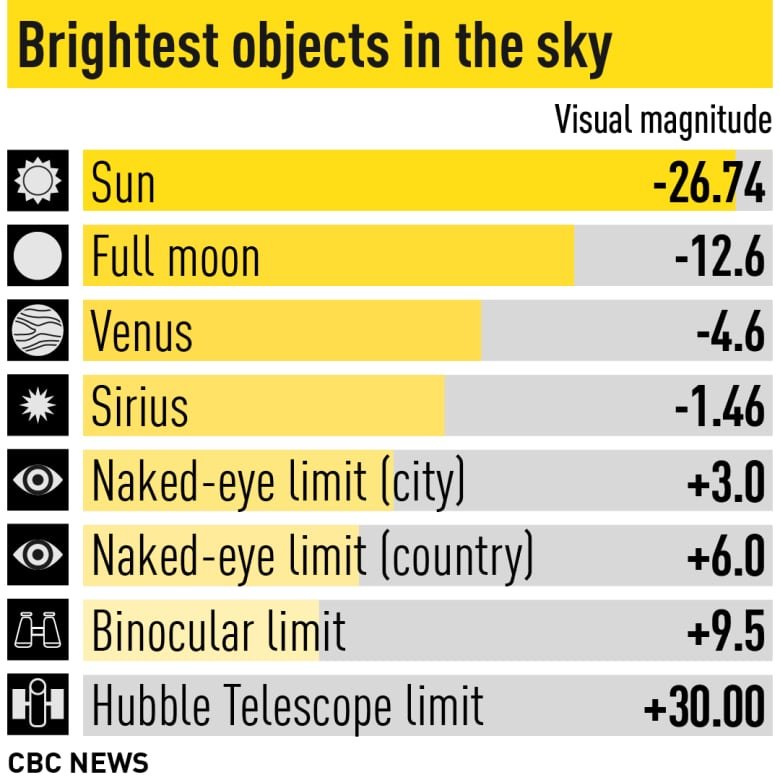If you have clear skies this weekend, now is the time to head out to try to catch a glimpse of the naked-eye comet, C/2023 A3 (Tsuchinshan–ATLAS).
This comet had garnered a lot of attention recently over the chance it could brighten to naked-eye visibility, and it seems to be playing out.
Comet C/2023 A3 (Tsuchinshan–ATLAS) was discovered by observatories in China and South Africa in early 2023. Believed to have originated from the Oort Cloud — a giant spherical shell that surrounds our solar system and contains billions of icy objects — this little comet has been slowly making its way into our solar system.
There was some fear that the comet might not survive its closest approach to the sun — called perihelion — which occurred on Sept. 27, but it did. Now the comet is making its closest approach to Earth, at roughly 71 million kilometres away.
WATCH | How to see the ‘once every decade’ comet A3 passing by Earth
In a year that included a rare total solar eclipse visible in parts of eastern Canada, as well as the most visible northern lights in decades, comet Tsuchinshan–ATLAS, also known as A3, is dazzling stargazers the world over as it passes near Earth.
While there were some reports that this could be the “comet of the century,” or the “comet of the decade,” that was a bit of an oversell, because comets are notoriously difficult to predict: astronomers can’t predict when we will get a new comet or how bright one may get.
Still, recent images have it hanging on quite well. A satellite that monitors the sun also managed to capture it looking quite bright.
Comet C/2023 A3 (Tsuchinshan-ATLAS) passes in between Earth and the sun as seen from the Solar and Heliospheric Observatory satellite.
“Its magnitude has been hard to determine … but its does not seem to be fading, so we do expect it to become visible in the northern hemisphere in the evening sky in a few days,” said Paul Wiegert, a professor at Western University’s department of physics and astronomy in London, Ont.
Comet C/2023 A3 (Tsuchinshan–Atlas), which last graced our skies during the Neanderthal era, is making its grand return. <br><br>On October 12, it will pass by Earth at about 44 million miles. If you want to catch a glimpse, look toward the western horizon just after sunset this… <a href=”https://t.co/anFAm7Sors”>pic.twitter.com/anFAm7Sors</a>
—@lecucos
That’s good news, since a recent paper entitled “The inevitable endgame of Comet Tsuchinshan-ATLAS (C/2023 A3)” published on the pre-print service arxiv.org suggested that “based on its past and current performance, the comet is expected to disintegrate before reaching perihelion.”
How wrong it was.
How to see it
Right now in Canada, the comet can be found low in the horizon in the west just after sunset.
And be warned: Don’t expect to see what you see in photographs. These are usually taken with telephoto lenses, and sometimes many images are combined, or stacked, to get a better final image.
Right now the comet is at a brightness of roughly -2 on the brightness magnitude scale, which makes it quite visible.

To find the comet, look to the west after sunset on Oct. 12, when it will be at its closest to Earth. You can still find it in the days proceeding its closest approach.
If you want to know exactly when for your particular location, you can use astronomy apps like Sky Safari, Star Walk, Stellarium or SkyView. Online, you can also check out The Sky Live, which allows you to put in your location and provides a live sky map for your location.
And while a comet gracing our sky has the potential to put on a beautiful show, there’s more to it than that. It’s believed that comets may have been the seeds that brought water to Earth billions of years ago.
“Anything that helps us understand the mystery of the icy outer solar system is always a good thing, and comets in particular have captured imaginations of humans probably forever,” Elaina Hyde, director of the Allan I. Carswell Observatory at Toronto’s York University. said.
“It’s not just a dirty snowball, as some scientists like to say. Actually, some comets can have traces of basically the formation of our own solar system. [They] tell us how things were formed. Tell us why, or help us understand why the solar system looks like it does. And the bigger questions are always how did our planet end up with life? How did our planet end up with water?”



